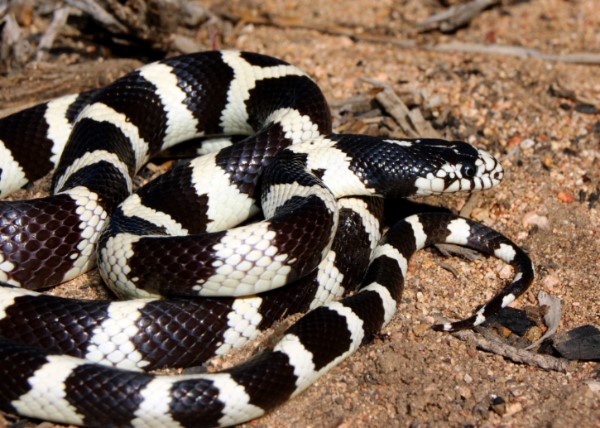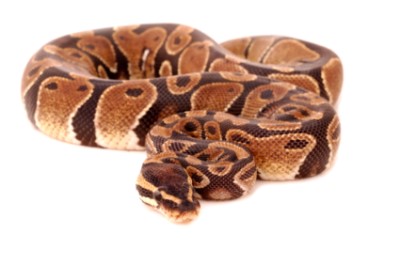Common Reasons for Surrender
People move, go to college, have kids, or experience some life change or significant event, and they can’t keep all of their pets. Reptile rescuers say that some families will find someone to take in a cat or dog, but choices are limited when wanting to find someone who will permanently take in your pet snake.
Pros
One of the best things about king and milk Snakes is that they stay a manageable size—three to four feet depending on the species of King or Milk—and people feel more comfortable with that. They also come in bright oranges, reds, yellows, and there is a variety to choose from.
Snakes in general require little maintenance from day to day, unlike a dog that requires attention a few hours every day. You can actually go away for the weekend and the snake will be intact and content upon your return.
People also find these snakes more interesting because in the wild they will eat a number of different things, including other venomous snakes, while a lot of reptiles will eat only one or two things.
Cons
The milk and king snakes are not quite as amiable as a corn or rat snake. They can be sociable, but they require regular handling for them to be tamed or settled down.
A king or a milk snake pet in captivity will need to be fed a frozen rodent every week or two, unless in hibernation. Some people do not like the idea of rodents in their freezer or feeding a whole mouse or rat (thawed from the freezer or alive) to a snake.
Diet
Kings and milks eat once a week. Over the winter it may only be once a month. If the frequency of feeding isn’t interesting enough, the actual diet can be termed fascinating or gross. The milk and king snakes eat other snakes, rodents, lizards, birds, and bird eggs in the wild. A king or milk snake in captivity is usually fed frozen rodents. Rescuer Jesse Rothacker orders his frozen rodents from Rodent Pro. The easiest way to prepare a frozen mouse is to remove the frozen mouse (or rat if the snake is bigger) from the freezer bag and place it in a bowl of hot water on top of the cage. This is a benefit to the snake because it gives them extra time to pick up the scent of the rodent.
When feeding your snake, always give her an extra drink to wash it down. Water can be put in a bowl the size of a cereal bowl filled with three quarters water and leave it in the tank. Change it every couple days to keep it fresh.
Exercise
The king and milk snakes like to have a couple things in their tank to climb. They also like to burrow under their bedding, which gives them enrichment and exercise. Some people take their snake out of the tank to handle him and to give him some exercise.
Possible Health Issues
Improper heating causes health issues. When you set up your tank, make sure you put the heat lamp on one side of the tank, not in the middle. You need to have a cool side so the snake can get away from the heat. If you see your snake on both sides of the tank, you are probably doing a good job keeping one side cool and the other side warm.
Housing
You will need a 20 to 50 gallon tank that is set up with a heat lamp (also called a dome light) from 60 to 100 watts on one side of the tank so that your snake has a hot side and cool side. Snakes have to thermal regulate themselves to keep their bodies balanced. Your tank can be glass, plastic, or a combination of both. The snake definitely needs holes that provide air and a secure lid so they do not escape. Branches should be set up so the snake can climb to get closer to the light. A basking rock should be placed under the lamp so the snake can bask in the heat on the rock. Aspen makes a good bedding on the floor of the tank for most snakes.
Grooming
If you use Aspen chips on the bottom of the tank, spray those chips, and they will absorb enough water to create humidity for these snakes whose habitat was in the south and are used to a more humid environment.
The king and milk snake sheds every two to three months. When a snake is about to shed, she will need a little more humidity to help her shed so that the skin comes completely off. If your snake sheds only partially, you can prepare a rubber container with plastic holes at the top for air, fill it partway with lukewarm water, and place your snake inside. Sometimes the snake can be left overnight, but usually the snake will shed her skin completely within a few hours with the help of the water dish.
Training
Most reptiles get friendlier with regular handling. Remember that your set up in the tank is more important than handling.
Entertainment
Kings and milks aren’t complicated creatures. If you set up an elaborate waterfall, your snake may get stressed out. King and milk snakes are happy with climbing branches, bedding, hiding boxes, and caves. If your snake can move around a little bit, he’s good.
ADDITIONAL RESOURCES
For interactive discussion forum go to www.herpcenter.com
http://www.reptilerescuealliance.org/
The Great Big Book of Snakes and Reptiles by Barbara Taylor and Mark O’Shea
We want to thank Jesse Rothacker, president of Forgotten Friend, Lancaster, Pennsylvania, for help with this profile.




